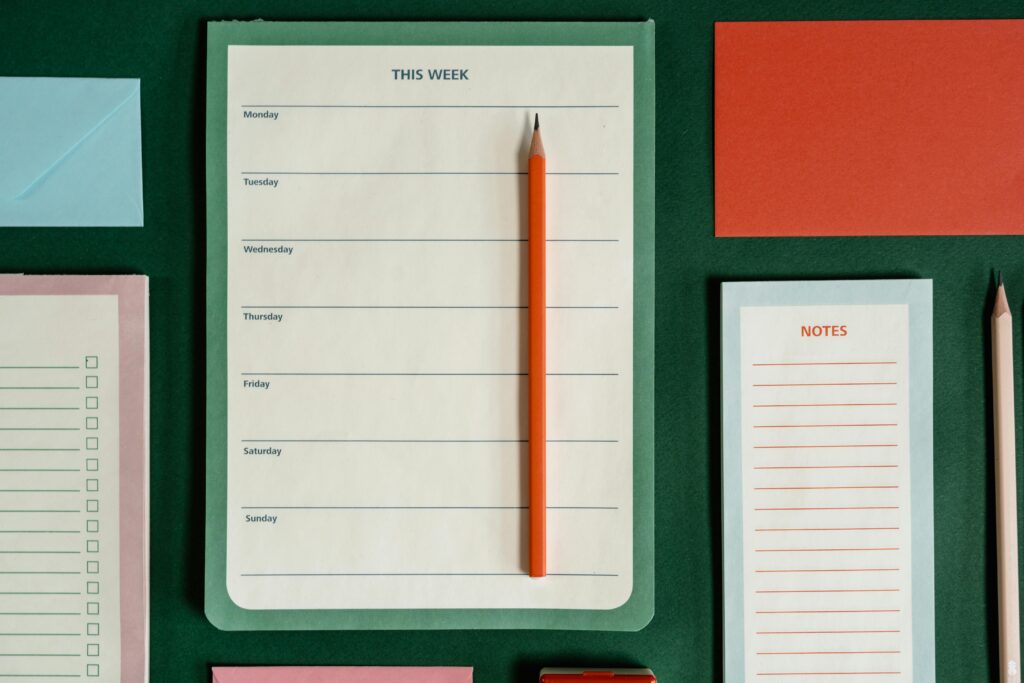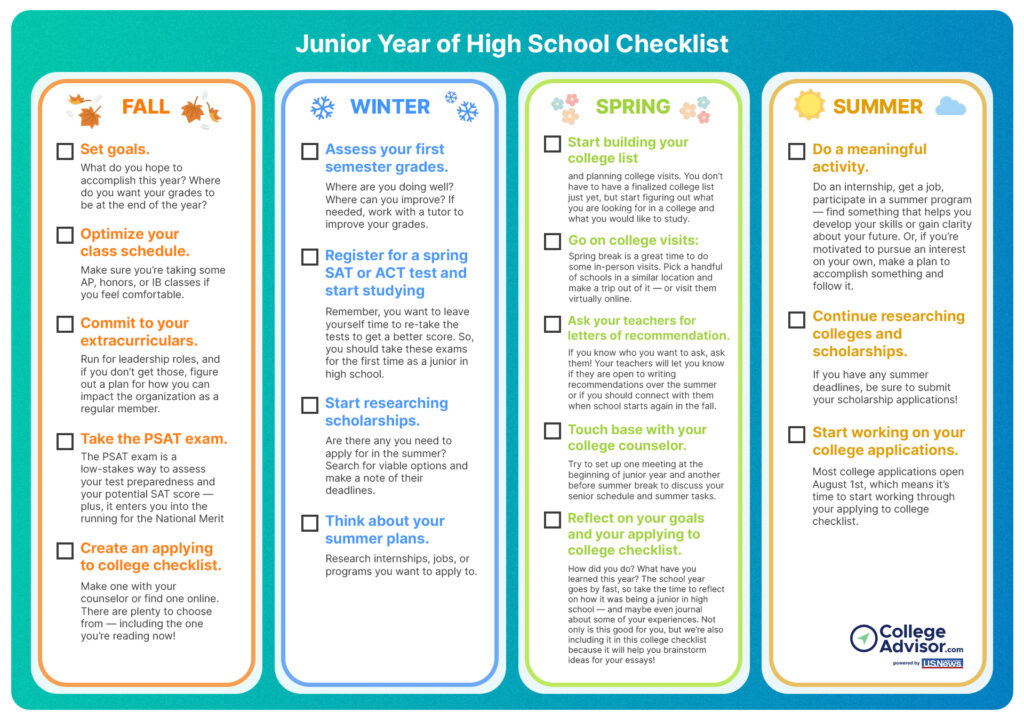
College Checklist for Juniors in High School
Although college applications aren’t due until senior year, there’s still plenty you can do as a junior in high school to prepare. From boosting your GPA to gearing up for standardized tests, junior year is a great time to get started on your college checklist. Staying organized and giving yourself action items can help you make meaningful progress — but how do you get started? One surefire way to set yourself up for success is by creating your very own preparing for college checklist.
In this article, we’ll discuss what you can do as a junior in high school to work toward getting into your dream college. We’ll lay out what should be included on your applying to college checklist.
In addition, this college checklist article will cover:
- Why your junior year is important for the college application process
- Relationships you should cultivate as part of your college checklist
- What to do in and out of the classroom to strengthen your applications
- Researching schools and building a balanced college list
- Searching for scholarships and internships
- Managing your time and activities to reduce stress and avoid burnout
- How to make the most of the summer before senior year, and more!
Still think junior year is too early to start the college application process? You might be surprised. Let’s start by discussing why you should start thinking about college when you’re still a junior in high school.
When do I need to start thinking about college applications?
Just like it’s never too late to pursue a college degree, it’s also never too early to start thinking about college applications. In fact, you may have even started making your college checklist as a freshman or sophomore. However, as a junior in high school, you have a real opportunity to start taking actionable steps toward your college goals.
There are several items that may go on your junior year of high school checklist. One is considering potential recommenders. The best college recommendation letters come from teachers who know you well and can speak to both your character and classroom performance. Choosing your recommenders early — and performing well in their classes — sets you up for stronger, more personal letters.
You can also start brainstorming college essay topics by reading past essay prompts and sample essays from schools on your list. While the prompts may change, the ultimate goal of your college essays remains the same — to share something meaningful about who you are and what you care about. Starting early takes some of the pressure off, and it gives you plenty of time to work through different ideas.
While the SAT and ACT may not be on your junior year college checklist, the PSAT certainly should be. Taking the PSAT exam in the fall of your junior year qualifies you for National Merit scholarships. Plus, taking the PSAT is a great way to get a feel for how you do in a standardized testing environment.
Getting ahead of senior year deadlines
College application deadlines usually fall sometime between November and January of your senior year. However, some application deadlines occur as early as September or October. Starting your college checklist as a junior in high school gives you the best chance of meeting those early deadlines with the strongest application possible.
Regardless of which deadline you apply for, balancing college applications with extracurriculars, classes, friends, and family obligations adds a lot of additional stress to senior year. Giving yourself time to slowly chip away at your preparing for college checklist can make the process more manageable.
Why Junior Year Matters

Your junior year plays a crucial role in demonstrating your readiness for college. Beyond significantly impacting your overall GPA, your junior year transcript is the last full year of records an admissions officer will review when evaluating your application. Junior year is the time to demonstrate your academic potential by earning high grades and taking challenging courses, including honors, AP, or dual enrollment.
As a junior in high school, extracurricular activities also become more important. Ideally, you will have been involved in some sports, clubs, jobs, or other extracurricular activities in your freshman and sophomore years. Junior year is the time to seek out leadership opportunities, awards, and other accolades to show passion and commitment. Some organizations also offer scholarships for juniors in high school, particularly for those in leadership positions. (Later on, we’ll talk more about why you should include applying to scholarships on your junior year of high school checklist.)
Junior year is also a great time to start thinking about your academic and career path. Juniors typically have access to more elective classes, so consider which subjects you’re passionate about and want to pursue. Think about classes you’ve enjoyed and how you can further explore those interests while building strong relationships with your teachers. You never know — they might end up writing glowing letters of recommendation, helping you check off another important item on your college checklist!
How to prepare for college applications
Prepping for college applications doesn’t have to be overwhelming. Actually, it should be quite the opposite! The main benefit of starting the college application process early is minimizing stress, so don’t worry about trying to do everything at once. Afterall, junior year is not the time to be finalizing your college list or college applications. Rather, it’s the time to narrow down your options and think about the direction you want to take.
Plus, you can make progress on your applying to college checklist simply by staying engaged throughout junior year. That means participating in your classes, getting to know your teachers, showing up to your extracurriculars, and thinking about your college goals. Moreover, spreading out your college checklist across the school year will prevent you from becoming overwhelmed.
Ready to go more in-depth with your preparing for college checklist? Let’s start with an easy action item: meeting with your counselor.
Meet with your counselor
As a junior in high school, one of the first steps you can take in the college application process is to meet with your school counselor. If you haven’t met with them before, schedule a one-on-one meeting with them. Depending on the size of your high school and the number of counselors, your counselor may be stretched thin. At some schools, counselors have more than 100 other students they are responsible for. Meeting with your counselor early can help you get any questions you have answered, and opens the door to more meetings throughout the school year.
Coming in with specific questions or goals will help you make the most of your meeting. One college checklist topic you can go over with your counselor is your course load. Counselors can help you choose classes that both strengthen your transcript and fulfill your school’s graduation requirements. They might also be able to help you enroll in college level courses as a junior in high school.
Additionally, you should find out what information they have regarding scholarship opportunities and standardized tests. Many counseling offices keep databases of community scholarships which are tailored to students at their school. They may also be able to direct you to test prep resources or fee waivers for the PSAT exam, SAT, or ACT.
Building a strong relationship with your counselor is an essential part of your preparing for college checklist. They are responsible for sending important information and documents to the colleges you apply to. They may even write letters of recommendation for you. In some cases, they may also offer other college application help, such as essay editing or building a college list. Your counselor can be a vital resource at any point in your high school career — don’t forget them.
Next, let’s highlight academic opportunities you can pursue as a junior in high school.
Double down on academics

As a junior in high school, your most important academic responsibility is to maintain or improve your GPA. Do not slack off or ignore your academic commitments to complete other items on your applying to college checklist. Your performance in your junior year classes provides a benchmark for colleges to see how well you’ll perform in college. If you are struggling academically, seek out help from teachers or tutors. Remember, you are not alone, and there are many people out there who want to help you succeed academically.
Every student has certain subjects that they enjoy and others they struggle with. Identifying which classes fall into which category is a crucial part of your applying to college checklist. For subjects you enjoy, look for ways to challenge yourself and develop your knowledge through AP, IB, or other advanced classes. These will both strengthen your academic transcript and potentially help you decide on a major down the road.
For subjects you struggle with, consider easier classes so that you can still earn good grades without burning yourself out. If you do earn a bad grade as a junior in high school, don’t despair. There are still many ways you can bounce back for a strong college application season.
Now is also the time to build strong study skills and self advocacy when it comes to academics. In college, you won’t have parents or teachers reminding you to complete assignments or study for tests. Therefore, as part of your junior year of high school checklist, make sure you are learning how to take charge of managing your time and academic workload. Use resources like planners or digital calendars to keep track of assignments and ask teachers or other adults for college application help if you need it.
Take the PSAT exam, SAT, and ACT
Standardized tests are designed to test students on material they should know before leaving high school. Although some schools are still test-optional following the pandemic, standardized tests are a required part of many college applications. And, while not sending scores won’t hurt college applications at test-optional schools, high scores can strengthen your application. If you’re not quite ready to take the SAT or ACT, let’s talk about a test you can and should plan to take as a junior in high school: the PSAT.
The PSAT is a test that most students take as a junior in high school. In some districts, the PSAT is sometimes administered during school hours, making it helpful for students with limited time. This test serves two main purposes. First, it provides some practice for the SAT. The tests have similar formats, so taking the PSAT will give you an idea of what to expect on the SAT.
Secondly, a good score on the PSAT will qualify you for a National Merit Scholarship, a prestigious award that includes money for college. In order to qualify for a National Merit Scholarship, you must take the PSAT in October of your junior year. Additionally, you have to earn a score that puts you in the top 50,000 test takers around the country. Even then, there are several rounds of selection before the finalists are ultimately determined.
The SAT and ACT
After taking the PSAT exam, one of the next steps on your college checklist should be taking the SAT or ACT. The tests are different, but most schools accept both scores as part of the college application process. It may be prudent to research the tests ahead of time and decide which one is right for you. The spring of junior year is one of the best times to take these tests. A spring test date gives you enough time to do a retake if you want to get a higher score.
There are many free or low-cost resources available for test prep and college application help for both the SAT and ACT. One of the best ways to study for both of these tests is to take practice exams. Try to replicate real testing conditions when you take practice exams: sit in a quiet room with a timer and no distractions. Learning to deal with the time pressure and question format can be as important as studying formulas and parts of speech.
Although nowadays, many schools are test-optional, standardized tests are still an important part of your junior year of high school checklist. In some cases, high test scores can compensate for lower grades and strengthen your college application. For schools that do require test scores, studying and preparing for these tests should be a core part of your college checklist. There are many resources available for college application help with tests, so be sure to take advantage of them!
Add schools to your college list

Another important action item for your junior year of high school checklist is making a list of schools to apply to. This step on your college checklist starts with researching colleges based on criteria important to you. These may include the school’s size, location, Greek life, athletic culture, and, of course, academic offerings. Use tools like the College Board’s BigFuture or the NCES College Navigator or visit college websites directly to learn more about the schools on your college checklist.
Visiting colleges is another good task to put on your college checklist. College visits give you the best insight into what a school is actually like. You can go on a tour, speak with students and professors, and attend events to get a sense of the school culture. Even if you cannot make it to an in-person visit, many schools now offer virtual tours! Virtual tours are great for exploring schools that are far away or difficult to visit in person. Some schools also offer online information sessions where admissions officers speak about the school and answer questions.
Narrowing down your college list
The next step is to compare schools and narrow down your options. Try to consolidate potential colleges and universities into a shortlist of schools you will likely apply to in your senior year. Though different experts recommend different numbers of schools, most agree that a well rounded college list should have eight to twelve schools.
Balancing your college list gives you a good chance of acceptance while also encouraging you to aim high. College lists should consist of at least two safety schools, or colleges where you have a high likelihood of being accepted. You should also have a few reach schools — ones you would love to attend but that are challenging to get into. The remainder of your list should be match schools, where you fit the average profile of an accepted student.
The next item on your preparing for college checklist: extracurriculars.
Stay involved in extracurriculars
When thinking about your college checklist, one of the most important pieces is your extracurriculars. Not every college checklist will include these, but that’s because extracurriculars should be a sustained part of your high school experience. However, as a junior in high school, now is the time to go after those leadership roles in your clubs and organizations: president, captain, director.
During the college application process, you’ll be asked to both list your extracurriculars with a brief description and reflect on them at length in short essays. You may even end up writing about your extracurriculars in your personal statement essay. This makes them one of the most important pieces of a college checklist to be thinking about when you’re a junior in high school.
Why are extracurriculars so important?
Colleges want to see what you care about, and how dedicated you are to those things. They also want to see whether you can make an impact in the organizations you’re a part of. One of the ways to do this is to pursue a leadership role — but a title alone isn’t enough. You’ll also have to show colleges what you did while you were in charge. As director of your a capella group, did you win any competitions or expand your repertoire? When you were president of the sustainability club, what initiatives did you undertake to turn your values into actionable change in your community?
Extracurriculars show what you’re passionate about and demonstrate that you have important skills, such as leadership and dedication. However, this doesn’t mean you need to be part of a hundred different clubs. When thinking about your college checklist, focus on depth over breadth. If you’ve been doing theater, track, or advocacy since freshman year, don’t drop it. Instead, look for ways to deepen your involvement.
If there’s a part of your identity or your interests that you feel hasn’t been reflected in your extracurriculars, consider adding a summer program, internship, or service project to your college checklist. As a junior in high school, the summer before senior year can be a great time to pursue a new passion or further explore one of your interests.
Research scholarship options

Instead of waiting until senior year, make researching scholarships part of your junior year of high school checklist. There are specific scholarships for juniors in high school — and some for seniors — that require you to do a project or write an essay. This takes time and planning, as does finding scholarships that fit your interests and background.
When adding scholarships to your college checklist, keep in mind that there are multiple types. There are need-based scholarships, which are awarded based on your family’s income and not tied to your academic performance. There is also merit-based aid, which is usually based on your GPA or other academic markers. You can also apply to private scholarships, which are grants given by outside organizations to help you pay for college. These usually require extra work, like an essay or letters of recommendation, to apply.
Exploring scholarships as a junior in high school is key to maximizing your scholarship opportunities. There are some scholarships for juniors in high school that you will miss out on if you don’t start looking early. And there are others that have deadlines over the summer before your senior year that you’ll need to be aware of in advance.
There are many online scholarship databases you can use in your search. You can search specifically for scholarships for juniors in high school, and you can even search based on your identity or interests. For example, there are specific scholarships for women pursuing STEM fields. Additionally, be sure to connect with your college counselor. They can help you build and navigate your college checklist, including where to look for scholarships. To keep track of your scholarship research for your college checklist, create a spreadsheet to track the eligibility criteria, deadlines, and required materials to apply.
Start thinking about recommendation letters
The next piece of your college checklist for junior year is to find your recommenders. These are the teachers who will write your letters of recommendation, a crucial component of the college application process. For many students, junior year teachers are the ideal recommenders. They can speak to your current academic standing and your most recent performance as a student, whether it be your character, strengths, or work ethic.
As a junior in high school, you’re taking classes with several potential recommenders. If there’s a teacher you get along with early on in the year, make a note of it. Then try to make your dedication to your studies and your future goals extra visible to your teachers. Participate in class discussions, go to office hours after class, and seek out feedback if you don’t do well on an assignment — or even if you do!
After identifying potential recommenders, you’re ready for the next item on your college checklist: asking your teachers for a letter of recommendation. If that makes you nervous, remember that your teachers are there to support you. Moreover, they understand the important role recommendations play in your college applications. So unless you have a bad relationship with a teacher (due to poor performance or disrespectful behavior), they will write one for you. Still, it’s important to build a relationship with your teachers throughout the year — you want recommendations that are specific and personalized to you.
To check this item off your college checklist, ask your teachers for letters of recommendation at the end of your junior year or beginning of your senior year.
Junior Year of High School Checklist
To help with the college application process, here’s a sample college checklist for a junior in high school. Feel free to print this out and use it as your own preparing for college checklist!

We hope this junior year college checklist is helpful to you! For more college application help, check out some of our other resources, like this guide on researching colleges.
Managing stress and avoiding burnout
Our junior year of high school checklist is meant to guide you through the school year and help you keep track of everything you need to know and do — not to increase stress. If you find that it makes you more anxious rather than feel more in control of your year, you can come up with a different process! There’s no right way to do it.
In order to maintain energy and stay on top of your mental health, try to get enough sleep, balance your courseload, and prioritize extracurriculars that matter to you. We know, everybody tells you to get enough sleep, but nobody’s telling your teachers to stop assigning so much homework. Do the best that you can, and practice prioritizing and time management.
It’s also important to set boundaries with social media and phone time. You can lock apps on your phone to turn off after a certain number of hours, or get a tool designed to physically lock your phone. In your downtime, prioritize seeing friends and family or getting outside.
You should also build downtime into your schedule — put it into your Google Calendar if you need to! No matter if you’re a senior or junior in high school, finding moments to rest is a crucial part of the college application process.
Making the most of your junior year summer

Summer is a great time to relax, spend time with friends, pursue activities that make you happy, and think about your college goals. It’s also a good time to make some progress on your college checklist.
Think about what you want out of your college experience, and what kind of college you want to attend. Do you have a potential major or career in mind? Do you want to attend a big or small school? What did you learn from your college visits? Reflecting on these things doesn’t take that much time. Doing so will also help bring clarity as you finish your junior year of high school checklist and move on to your applying to college checklist.
If you can, try and do something that leaves you feeling accomplished at the end of the summer. This can be mandated through a program or internship. You could also pursue a personal project with set, achievable goals.
If your junior year of high school checklist didn’t go exactly how you wanted it to, summer is a great time to make up for that. You can take courses over the summer to boost your grades. Or you might pursue an interesting program, internship, or project that demonstrates your persistence, passion, and work ethic outside of school.
Summer is also a good time to start thinking about your personal statement. Though the Common App doesn’t officially open until August 1st, you can check out the most recent essay prompts to start brainstorming ideas. Use the essay prompts for inspiration and just start freewriting or journaling. One of the most important pieces of advice that we give students looking for college application help is to make time to reflect on your goals, passions, and values.
5 tips to get a headstart on the college application process
Here are five tips to ace the college application process as a junior in high school.
5 College Application Tips to Get Ahead

1. Challenge yourself academically.
It’s a careful balancing act, but try your best to optimize your schedule for success. Now is the time to push yourself.
2. Map out your testing dates.
What month will you take the SAT/ACT? How many weeks do you think you’ll need to study? Will you take classes, buy a practice book and study yourself, or work with a tutor?
3. Prep your resume.
This means keeping a running list of your activities and accomplishments. Big or small, write it down so you don’t forget! You never know what will be useful for your applications.
4. Research colleges and scholarships.
Start looking up schools that you’re interested in, and don’t forget the financial part of college applications. Talk with your parents about finances and how much they’re able to contribute to your education. Make sure your college search takes your finances into consideration so you don’t set yourself up for disappointment.
5. Strengthen connections with teachers and counselors.
If there’s a teacher you like, go to their office hours! Additionally, speak up in class and turn in thoughtful work. Don’t get in trouble (obviously). Meet regularly with your college counselor — they’re often your first stop for college application help.
And remember: you’re still in high school, so have fun! Take nights off, plan your study time and your down time, have at least one class that has a lighter workload or engages you creatively, and see your friends. College prep is important, but so is being in high school. Don’t let your college checklist get in the way of enjoying it!
11th Grade College Checklist – Final Thoughts
When you’re a junior in high school, things start to ramp up. This college checklist will help you keep track of junior year responsibilities and tasks so you feel more prepared jumping into the college application process senior year.
Remember, junior year is:
- The most recent reflection of your academic performance — aim to make it your best work yet.
- A time to step into leadership roles, get involved in jobs or internships related to your interests, and start thinking seriously about life after high school.
- The year you’ll take key standardized tests like the PSAT, SAT, or ACT. Even if schools don’t require them, taking the tests early keeps your options open.
- When college planning gets real: you’ll start building your college list, researching scholarships, figuring out what’s realistic based on your academics and finances, and visiting campuses to see what fits.
The summer before senior year is also an essential time to demonstrate your passion and hard work to admissions officers — and to reflect on your high school career, what you want in your future, and how you’ll convey that in an application.
If you’re looking for more college application help, reach out to CollegeAdvisor. We have programs for students in every grade and more useful guides and articles like this one!

This article was written by Alex Baggot-Rowe and Rachel Kahn. Looking for more admissions support? Click here to schedule a free meeting with one of our Admissions Specialists. During your meeting, our team will discuss your profile and help you find targeted ways to increase your admissions odds at top schools. We’ll also answer any questions and discuss how CollegeAdvisor.com can support you in the college application process.
